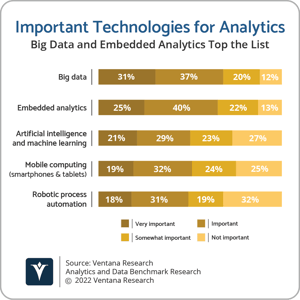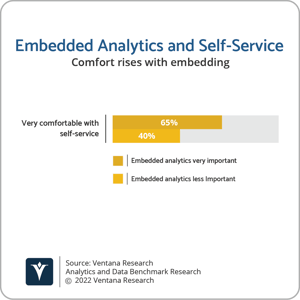When I looked at the state of analytics recently, it was clear that analytics are not as widely deployed within organizations as they should be. Only 23% of participants in our Analytics and Data Benchmark Research reported that more than one-half of their organization’s workforce are using analytics. There are many elements to becoming a data-driven organization, as my colleague Matt Aslett points out, but analytics are a necessary component. Our research shows that organizations recognize the importance of embedded analytics, ranking it the second most important digital technology in their analytics and data efforts behind big data and ahead of artificial intelligence and machine learning (AI/ML).
Embedding analytics into other applications and business processes addresses several key issues that often become barriers to success. First, the most time-consuming aspect of analytics is preparing data for analysis. When analytics are embedded into applications, the data-preparation process is built in. There’s no need to collect and integrate data. It’s been done already. Perhaps the data can be organized into a data pantry, making it easier for individuals to understand and utilize the data that is available to them. Embedding also addresses the most common complaint organizations report about their current analytics technology: it’s hard to integrate with their business processes.
analytics is preparing data for analysis. When analytics are embedded into applications, the data-preparation process is built in. There’s no need to collect and integrate data. It’s been done already. Perhaps the data can be organized into a data pantry, making it easier for individuals to understand and utilize the data that is available to them. Embedding also addresses the most common complaint organizations report about their current analytics technology: it’s hard to integrate with their business processes.
In addition, embedding analytics can help achieve more self-service within an organization. There’s no need to switch from a business application to an analytics application. The line-of-business workers can continue to perform their daily jobs using the applications to which they have become accustomed. Our research shows a correlation between embedded analytics and self-service. Of those organizations where embedded analytics are very important, two-thirds (65%) are comfortable allowing business users to work with data that has not been integrated or prepared for them by IT. Only 40% of other organizations are comfortable providing this same type of access.
they have become accustomed. Our research shows a correlation between embedded analytics and self-service. Of those organizations where embedded analytics are very important, two-thirds (65%) are comfortable allowing business users to work with data that has not been integrated or prepared for them by IT. Only 40% of other organizations are comfortable providing this same type of access.
Perhaps even more important is the blending of operational and analytical activities in many use cases. As organizations process more and more streaming data, the opportunity to process that data in real time enables organizations to become more responsive, providing a better customer experience. As I’ve noted previously, dashboards are not very useful when processing data in real time. The metrics produced by analytics processes need to drive automated recommendations and actions. For example, there’s little or no time for customer service representatives to review and interpret data when deciding how to help a customer on the phone or in a chat session. However, if the system can produce recommendations on the best next course of action, often using AI/ML, then the customer benefits from a better experience and the organization improves its bottom line.
Finally, there’s the issue of governance. When analytics are embedded into business applications and processes, there is less chance for violations of policies or regulations. The data remains within the domain of the business application. The manipulations of the data are controlled by the application or process in which they are embedded. So, it is no surprise to see a correlation between the adequacy an organization reports for its data governance and the importance of embedding to their analytics and data processes. Twice as many organizations (39%) for whom embedding is very important report their data governance technologies are completely adequate for their needs, compared with other organizations (18%).
Analytics and data vendors are recognizing the importance of embedding. Nearly all analytics vendors have been investing in their APIs, providing more functionality via APIs and providing better granularity to their various components. This approach helps organizations embed analytics in their own applications and in their services to customers. Analytics vendors are also focused on helping other technology vendors embed their capabilities in a range of enterprise software from business applications to middleware. They’ve also invested in supporting continuous integration and continuous delivery (CI/CD) processes that many organizations use to develop and deploy applications. These enhancements will make it easier to take advantage of all that embedded analytics have to offer. Embedded analytics will not replace all ad hoc or custom analytics, but I encourage you to consider them wherever possible in your organization.
Regards,
David Menninger


 analytics is preparing data for analysis. When analytics are embedded into applications, the data-preparation process is built in. There’s no need to collect and integrate data. It’s been done already. Perhaps the data can be organized into a
analytics is preparing data for analysis. When analytics are embedded into applications, the data-preparation process is built in. There’s no need to collect and integrate data. It’s been done already. Perhaps the data can be organized into a  they have become accustomed. Our research shows a correlation between embedded analytics and self-service. Of those organizations where embedded analytics are very important, two-thirds (65%) are comfortable allowing business users to work with data that has not been integrated or prepared for them by IT. Only 40% of other organizations are comfortable providing this same type of access.
they have become accustomed. Our research shows a correlation between embedded analytics and self-service. Of those organizations where embedded analytics are very important, two-thirds (65%) are comfortable allowing business users to work with data that has not been integrated or prepared for them by IT. Only 40% of other organizations are comfortable providing this same type of access.








